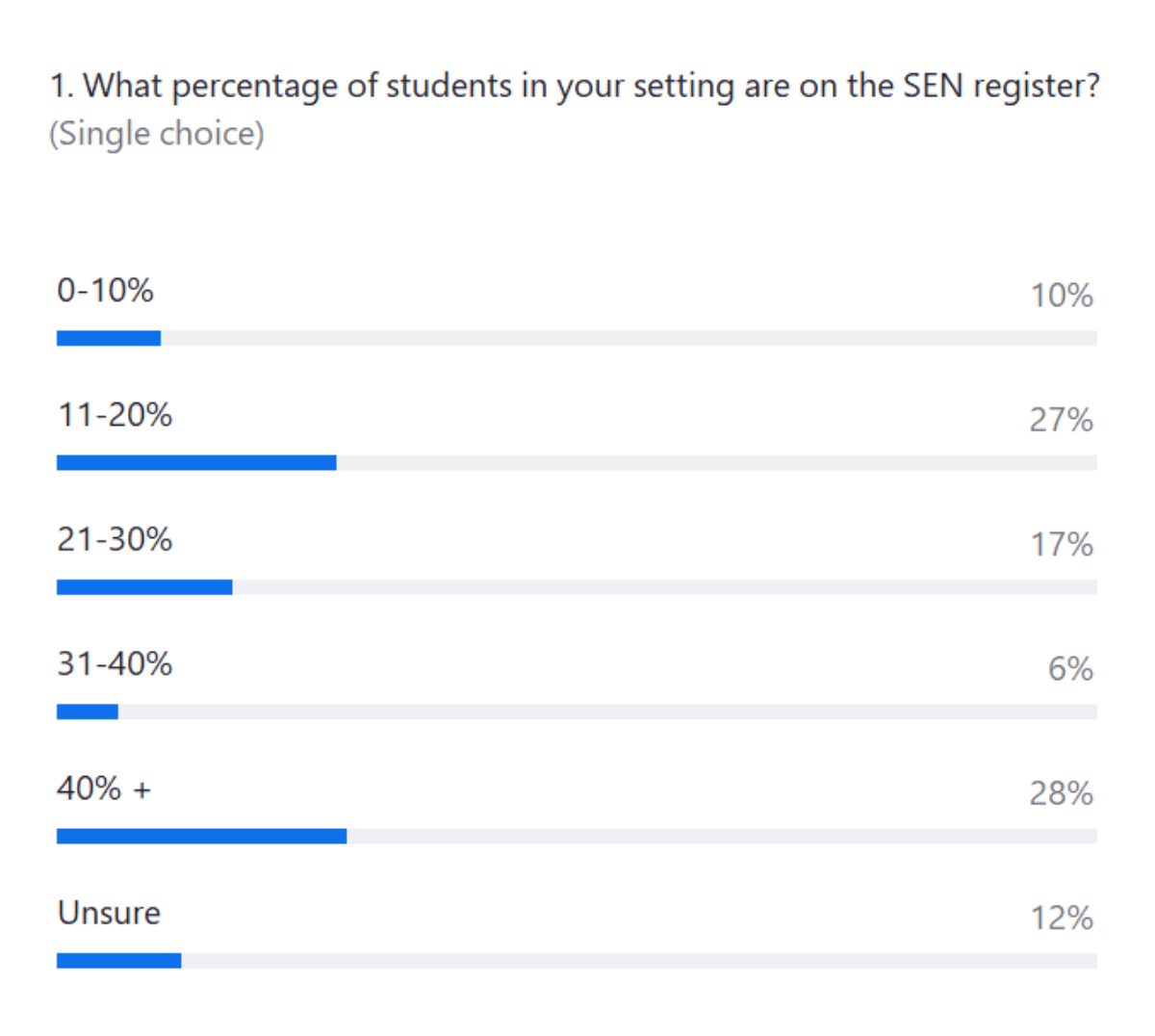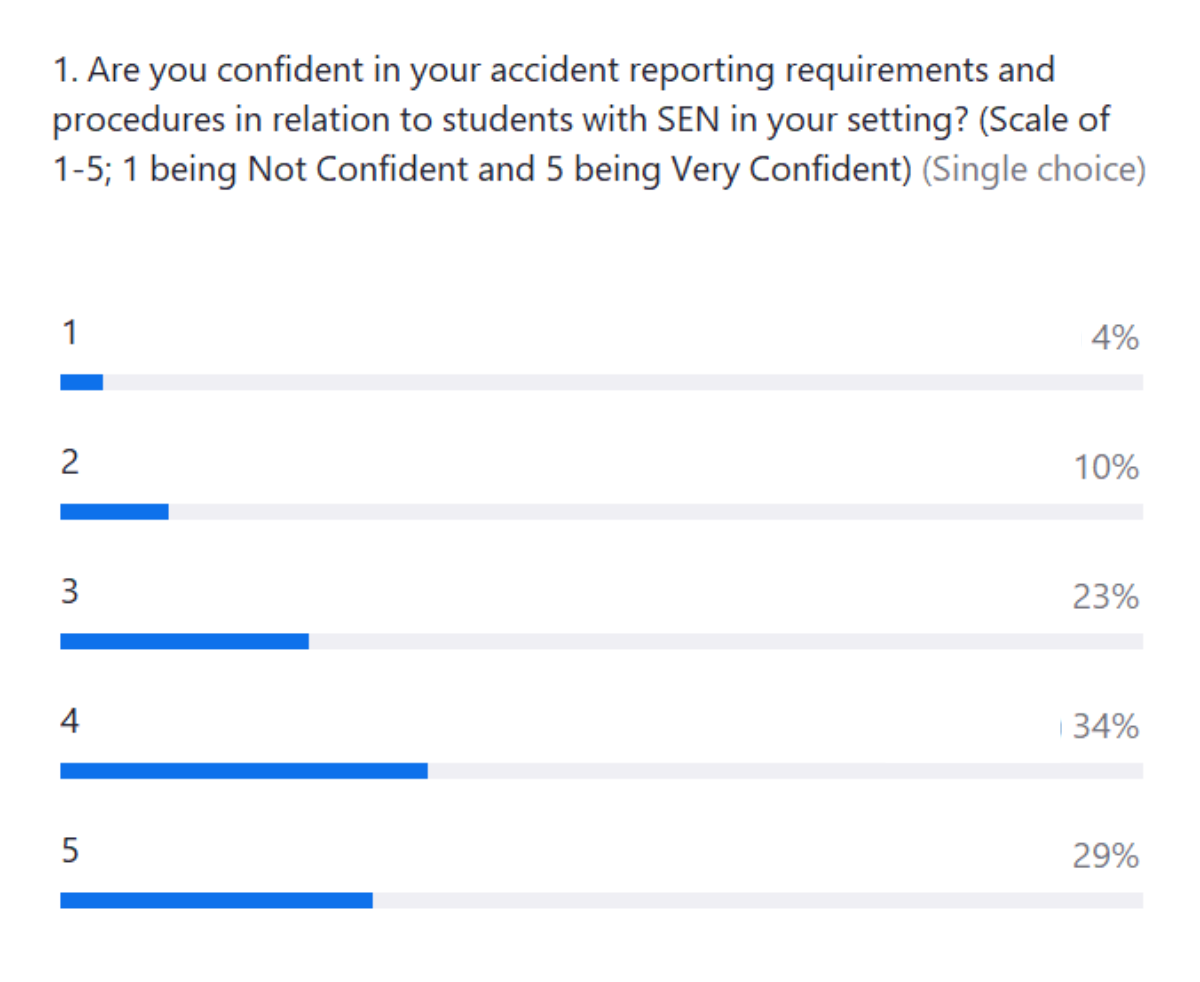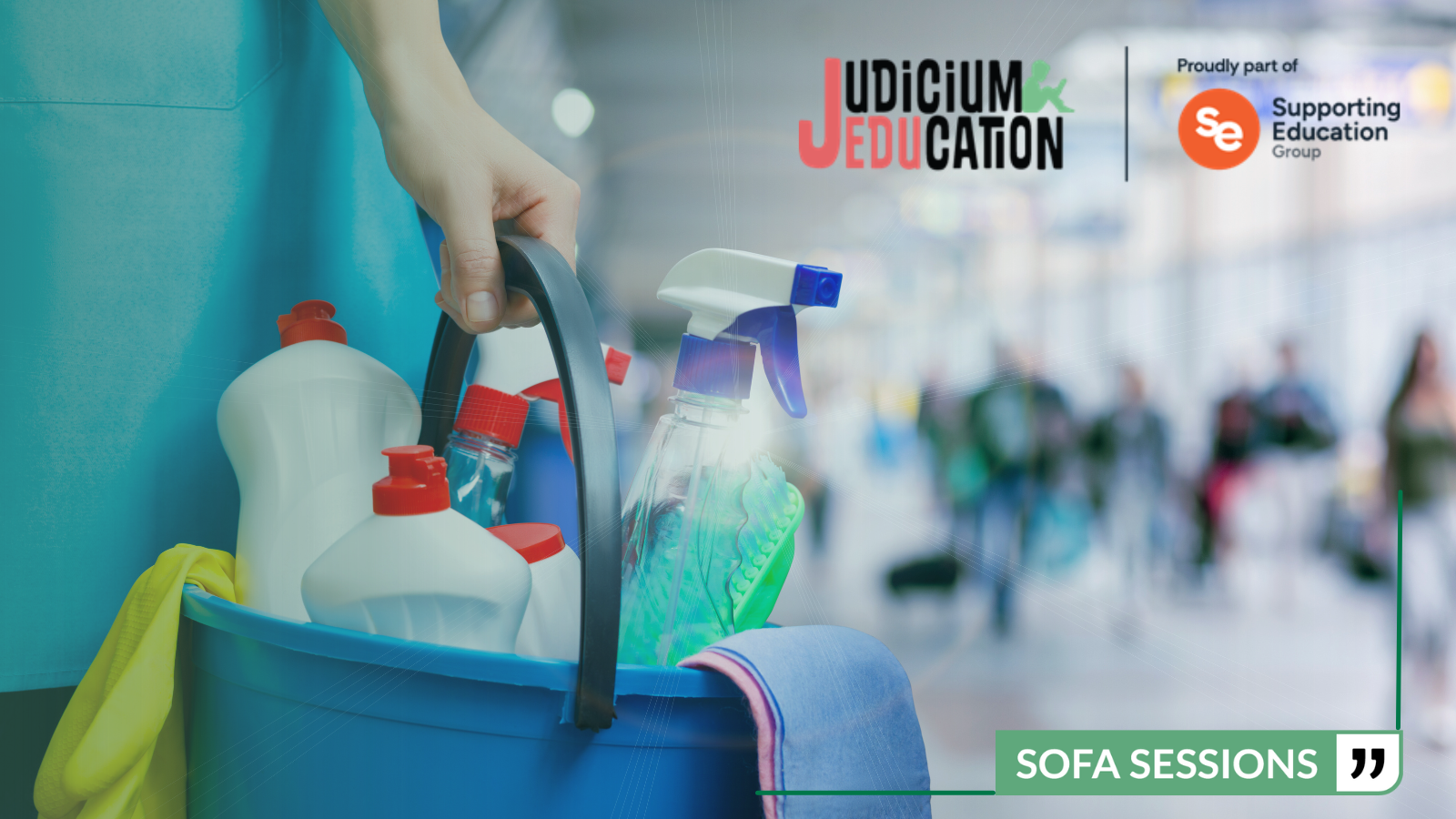From Risk to Readiness – Strategic Health & Safety for SEND Inclusion
_1000.png)
This blog is based on Judicium’s Health & Safety and SEND session on 26th November with resident expert India Cottenden.
Poll 1

Preparation and Planning
Though over 1.7 million students in England have special educational needs, over 1.2 million of those students don’t have an EHCP.
EHCPs clearly outline the special educational needs of the student, their health or social care needs and their required special educational provision. So if over 62% of students with SEN don’t have an EHCP how can we know what provision they may require to not only thrive in school but also to keep them and those around them safe?
A community to Help
Where appropriate, involve the child in identifying the support they feel would be most helpful. Engage parents and carers to build a clearer understanding of their needs, and involve medical professionals when required. It is also important to liaise with previous schools, as they can provide valuable background information and insight.
Example:
A year 3 teacher had a student with an autism diagnosis in their class, and had worked really hard with their parents and previous teachers to create a great environment for him. By February he was making amazing progress and was very settled. However, they then found out they would have another student joining their class after the Easter holidays, who also had a diagnosis of autism. Though it was encouraged by their school to wait and see how it would go, they spent hours planning and preparing for this drastic change. For example, they only had one safe space within their classroom which was used by the current student.They made contact with the new student previous school and spoke to their teacher to find out further information to help ease the transition. She also invited the student mum into school on multiple occasions prior to their start date to help provide feedback and guidance on her plans. Ultimately, it all paid off and yes there were challenging moments, but ultimately it made everything much more smooth and uneventful.
School Setting
Other important factors to consider is the physical environments that they will be accessing. Will they be able to manoeuvre within the classrooms, play areas and circulation spaces with ease? Have security measures been implemented as needed. For example, access control for students known to elope and locked cabinets to store potentially dangerous items? Signage or safety information within the classroom, is it accessible? Social stories? Pictorials?
Preparation and Training
We must consider whether additional instruction or training must be provided to relevant employees. This may be due to medical needs, or the use of specialist equipment, moving and handling people training or de-escalation training. It may also include training regarding the students’ specific SEN, such as autism awareness or supporting students with ADHD.
The final point I wanted to discuss when preparing and planning for a student with SEN to join your school or classroom is ensuring that activities are inclusive and accessible. Ask yourself ‘how can I adapt this activity to still meet the goals and reap the benefits for the student, without putting them in an unsafe or uncomfortable situation?’ A couple of examples could be adapting an activity to include less overwhelming environments for a student with sensory needs, or ensuring that a visual fire alarm is installed in areas in which a student with a hearing impairment may occupy.
Our Health & Safety service provides over 40+ documents to our clients when developing and managing H&S for their SEN students, which we advise during audits and termly reviews. For more information click here.
Poll 2
.png)
We thought about the controls to put in place before a student with SEN joins your school, so is that all we need to do? If we have the perfect paperwork and risk assessments in place, will nothing go wrong?
It's vital to have this paperwork and have done due diligence in regards to planning and preparing for the student, however this does not mean nothing could do wrong. Ensuring that the necessary levels of supervision are in place is so important. This may be due to medical needs or that the student may not be able to recognise everyday hazards, communicate distress or react in an emergency.
Example:
In a recent case, several families from West Sussex raised serious concerns about children with SEND being placed in unsafe environments due to gaps in support and supervision. In one instance, a 10-year-old girl with complex needs repeatedly injured herself during unstructured time at school because key provisions outlined in her support plan were not consistently implemented. Her parents eventually withdrew her from school entirely, not as a choice—but as a safeguarding decision, believing she was no longer physically or emotionally safe on site.
Another family described similar challenges after their 8-year-old son began experiencing frequent incidents at school, sometimes involving harm to himself and other children. Although he was entitled to one-to-one support, this provision was no longer available, and the family felt they had no option but to remove him to prevent further risk. Nine months later, no suitable alternative placement had been identified.
Dynamic risk assessment is crucial for supporting students with SEN in schools because it allows employees to respond to changing circumstances in real time. Unlike static risk assessments, which are completed in advance, dynamic assessments involve continuously evaluating the environment, the student’s behaviour, and potential hazards as situations unfold. This proactive approach helps ensure safety while promoting inclusion, as employees can adapt strategies to prevent harm without unnecessarily restricting participation.
The ability to dynamically risk assess relies on having an understanding of the behaviours and needs of the student, which is where behaviour plans come in. These plans are typically completed ahead of a student joining the school where possible, however it’s vital to remember that these should be live documents, being updated whenever new information is identified. Typical information within behaviour plans include identified needs and triggers, preventative strategies and intervention strategies.
Preventative strategies
These are things we can do to help a student to stay safe as well as feel safe within the school environment.
Things to consider:
- Environmental changes
- Communication strategies
- Teaching coping strategies during calm periods
Poll 3
.png)
Emergency Planning and Response
Remembering that our plans and documentation for student with SEN are live documents is so important, as are recognising near misses and taking action accordingly.
PEEPs
In order to be able to act correctly in the event of an emergency, or an undesirable situation, we must have the necessary plans in place. A very simple example is having PEEPs in place. This may be for students with limited mobility or visual impairments, but they should also be in place for students who generally may require some additional assistance in the event of a fire alarm activation. For example, do they have noise sensitivities and therefore will likely become very upset when the alarm is triggered? Does the student have limited communication, so would potentially require assistance to evacuate the building in a timely manner?
For our clients, we have a PEEP template and we will ask about the procedures for completing PEEPs during our fire risk assessments. We also will review the provisions for those with disabilities or SEN to make sure that everyone can evacuate the premises safely, such as emergency voice communication systems in refuge areas
Example:
A teacher recorded the sound of the fire alarm and played it at a lower volume, increasing the volume and playing it without warning over time to help the student to become desensitised to it.
Another approach to emergency preparedness is ensuring that information is communicated in a way that the student will best understand.
Example:
Using social stories to show students what to do if they hear the fire alarm or during a lockdown drill. Social stories can also be used to share coping strategies and model positive behaviours.
Intervention strategies
These are your plan A, B and C for if a student is becoming, or has become, dysregulated or is behaving in an unsafe manner. Your first steps will be identifying early intervention cues and implementing strategies before the behaviour may escalate. For example, would they benefit from a sensory break as today has been quite overstimulating and overwhelming? Or is it time for some positive reinforcement and to change their activity to something they enjoy or find calming?
Poll 4

Having a central accident book for situations which required support from a first aider, and then a classroom log for minor incidents. It not just a requirement from the perspective of recording accidents, it also a vital source of information to identify trends and common issues, which is another question we will ask during our audits. It can help to identify if further measures may be required
Another requirement surrounding accidents and incidents is the need to investigate them. We want to do this for all accidents regardless, to a varying degree, and in the context of students with SEN it can help us to identify areas for improvement in our procedures and also to highlight positive measures. These accident investigations are something we can help our clients with, and I have done so in a couple of instances already
However, if a students behaviour has become unsafe for themselves or those around them it is time to implement the crisis management procedures. What these procedures are may vary greatly between students, however they typically would include removing other students and unnecessary or untrained employees from the area, following the schools procedures for summoning assistance and implementing strategies identified within the students behaviour plan. The situation may require physical intervention if the student is posing harm to themselves or others. If so, this must be implemented in line with the employees training and the schools positive handling policy.
Top Tips
1) Have open conversations with the student where possible, or those who know them best
2) When it comes to protecting the safety of students with SEN and those around them, it’s much better to be overprepared and have an abundance of caution, as even the smallest negative experience can have a lasting impact
Judicium Education can help
For our Health and Safety Clients, we have a breadth of templates available on our JEDU platform. Log in here.
If your school needs support, to ensure your schools programme is legally compliant, we’re here to help.
Judicium Education’s Health and Safety, Facilities Service is designed to support schools, firstly, in ensuring a safe working and learning environment, secondly, in complying with the legal requirements imposed on them as employers under the various Health & Safety laws and regulations. For more information, please visit here.
If you require any support in any of these steps or would like to talk to someone surrounding some support for your school or trust, please do not hesitate to call us on 0207 336 8403 or email Georgina.decosta@judicium.com.
If you’d like to review Judicium’s forthcoming sofa sessions please click here
© This content is the exclusive property of Judicium Education. The works are intended to provide an overview of the sofa session you attend and/or to be a learning aid to assist you and your school. However, any redistribution or reproduction of part or all of the contents in any form is prohibited. You may not, except with our express written permission, distribute or exploit the content. Failure to follow this guidance may result in Judicium either preventing you with access to our sessions and/or follow up content.
Related content
.png)
This blog is based on Judicium’s Food Safety Sofa session on 12th November with resident experts Sue Roberts and Tracey Killick

This blog is based on Judicium’s Health and Safety ‘Sofa Session’ on the 15th of October, with our resident expert Mike Wright.

This prestigious award celebrates our commitment to delivering expert, education-specific Health & Safety support that lifts the burden for school teams while raising safety standards across the sector.

This blog is based on Judicium’s Health and Safety ‘Sofa Session’ from 18th June, led by resident expert , Mike Wright, CMIOSH. This session focuses on the control of substances hazardous to health (COSHH) and their relevance in school settings, how assessments should be undertaken and what staff could be at risk.

Discover why Judicium has been shortlisted for Fire Safety Consultancy of the Year at the 2025 FSM Awards, recognising our expert support for schools and trusts in delivering sector-specific, compliant, and practical fire safety solutions.
.png)
This blog is based on Judicium’s Health and Safety ‘Sofa Session’ from the 12th of March, with our resident expert Mike Wright.

Sofa Sessions | H&S